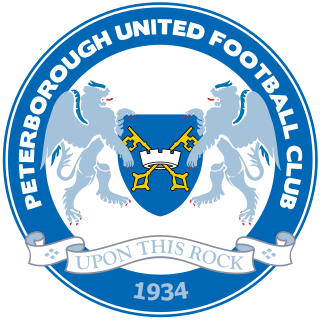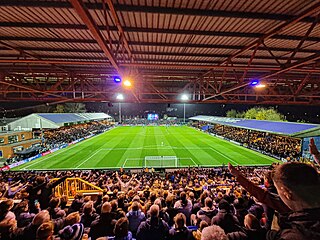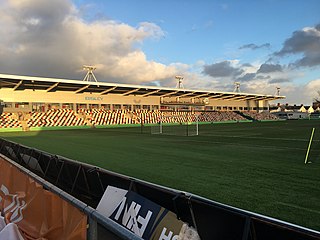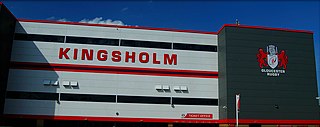
Easter Road is a football stadium located in the Leith area of Edinburgh, Scotland, which is the home ground of Scottish Premiership club Hibernian (Hibs). The stadium currently has an all-seated capacity of 20,421, which makes it the fifth-largest football stadium in Scotland. Easter Road is also known by Hibs fans as "The Holy Ground" or "The Leith San Siro". The venue has also been used to stage international matches, Scottish League Cup semi-finals and was briefly the home ground of the Edinburgh professional rugby union team.

Molineux Stadium is a football stadium situated in Wolverhampton, West Midlands, England, has been the home ground of Premier League club Wolverhampton Wanderers since 1889. The first stadium built for use by a Football League club, it was one of the first British grounds to have floodlights installed and hosted some of the earliest European club games in the 1950s.

Peterborough United Football Club is a professional association football club based in Peterborough, Cambridgeshire, England. The team compete in League One, the third level of the English football league system.

Edgeley Park is a football stadium in Edgeley, Stockport, England. Built for Stockport RFC, a rugby league club, in 1891, by 1903 the rugby club was defunct and Stockport County Football Club moved in. The ground is set to be increased to a capacity of around 18,000 with the start of the project in 2025.

Villa Park is a football stadium in Aston, Birmingham, with a seating capacity of 42,640. It has been the home of Premier League club Aston Villa since 1897. The ground is less than a mile from both Witton and Aston railway stations and has hosted sixteen England internationals at senior level, the first in 1899 and the most recent in 2005. Villa Park has hosted 55 FA Cup semi-finals, more than any other stadium, and it is the 10th largest in England.

White Hart Lane was a football stadium in Tottenham, North London and the home of Tottenham Hotspur Football Club from 1899 to 2017. Its capacity varied over the years; when changed to all-seater it had a capacity of 36,284. The stadium was fully demolished after the end of the 2016–17 season.

Fratton Park is a football ground in Portsmouth, Portsea Island, England and is the home of Portsmouth F.C. Fratton Park's location on Portsea Island is unique in English professional football, as it is the only professional English football ground not located on the mainland of Great Britain. Fratton Park has been the only home football ground in Portsmouth FC's entire history.

Adams Park is an association football stadium in High Wycombe, Buckinghamshire, England. Built in 1990, it is the home ground of the local Wycombe Wanderers in League One. It was also leased from 2002 to 2014 to the rugby union club London Wasps from Aviva Premiership, and from 2016 to 2020 to the Reading F.C. Women football club. From the 2003–04 season to the 2005–06 season, the stadium was officially called Causeway Stadium, named after its sponsor Causeway Technologies.

The Abbey Stadium, known as the Cledara Abbey Stadium for sponsorship reasons or just the Abbey, is a football stadium in Cambridge, England. It has been the home ground of Cambridge United F.C. since 1932, and currently has a maximum capacity of 7,937 spectators. Cambridge Regional College F.C., Cambridge United's feeder club, played their home games at The Abbey from 2006 until their dissolution in 2014.

Headingley Stadium is a stadium complex in Headingley, Leeds, West Yorkshire, England. Linked by a two-sided stand housing common facilities, it comprises the two following separate grounds: Headingley Cricket Ground and Headingley Rugby Stadium.

Welford Road is a rugby union stadium in Leicester, England, and is the home ground of Leicester Tigers. The ground was opened on 10 September 1892, and is located between Aylestone Road and Welford Road on the southern edge of the city centre. The ground was developed in two main periods: either side of the First World War stands were built on both sides, and then between 1995 and 2016 both ends were developed and the north side redeveloped. The stadium has a capacity of 25,849, making it the largest purpose-built club rugby union ground in England. It hosted five full England national team matches between 1902 and 1923, and staged a single match at both the 1991 and 1999 Rugby World Cups.

The County Ground is a stadium located near the town centre of Swindon, Wiltshire, England, and has been home to Swindon Town Football Club since 1896. The current capacity of 15,728, all-seated, has been at that level since the mid-1990s. A record attendance of 32,000 was set on 15 January 1972, against Arsenal in the third round of the FA Cup. North of the football stadium is Swindon Cricket Club, with their pitch also named The County Ground following its use by the football club from 1893 until 1896.

Roots Hall is a football stadium located in Southend-on-Sea, Essex, England. The stadium is the home ground of the National League team Southend United. With a capacity of 12,392, Roots Hall is the largest football stadium in Essex. During the early 21st century, there was lengthy discussion of a new 22,000 seat stadium at Fossetts Farm, but a change of ownership in 2023 seemingly ended prospects of that development.

Gresty Road or the Alexandra Stadium, currently known as the Mornflake Stadium for sponsorship reasons, is a football stadium in Crewe, Cheshire, England. The home ground of Crewe Alexandra, it has an all-seated capacity of 10,153.

Rodney Parade is a stadium in the city of Newport, South Wales. It is located on the east bank of the River Usk in Newport city centre. The ground is on Rodney Road, a short walk from the city's central bus and railway stations via Newport Bridge or Newport City footbridge. There is no spectator car park at the ground but a number of multi-storey car parks are nearby.

Belle Vue, also known as the DIY Kitchens Stadium for sponsorship reasons, in Wakefield, England, is the home of Rugby League club Wakefield Trinity RLFC and Association Football club Wakefield A.F.C. It is on the A638 Doncaster Road, a mile south of Wakefield city centre.

Kingsholm Stadium is a rugby union stadium located in the Kingsholm area of Gloucester, England, and is the home stadium of Gloucester Rugby. The stadium has a capacity of 16,115. It is sometimes nicknamed 'Castle Grim', after the estate where the stadium is built. The new main grandstand, opened in 2007, is an all-seated 7,500 capacity stand along the south touchline. It is currently sponsored by Malvern Tyres.

Seaview is a football stadium in Belfast, Northern Ireland. It is the home ground of Crusaders, and traditionally hosts the final of the Steel & Sons Cup on Christmas Day. The stadium holds 3,383, and has a 4G playing surface.

Damson Park is an association football stadium in Solihull, West Midlands, England. It was the new home of Solihull Borough following their departure from their original Widney Lane Ground. It is now the home of Solihull Moors, the club formed when Solihull Borough and Moor Green merged in 2007. They previously shared Damson Park with Birmingham & Solihull R.F.C. and also used to have an agreement that allows Birmingham City Reserves the use of the ground for their reserve games. Birmingham City W.F.C. of the FA WSL have used Damson Park for home games since 2014.

Headingley Rugby Stadium is a Rugby League stadium in Headingley, Leeds and shares the same site as Headingley Cricket Ground. It is the home ground of the Leeds Rhinos. Headingley is the 5th largest rugby league stadium in England.






















